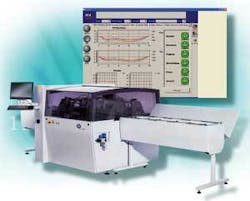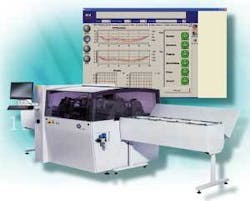Industrial cameras ensure perfect products
Andrew Wilson, Editor, [email protected]
Modern printing systems use direct-to-plate printing to eliminate the film-imaging step by imaging directly on the plate material. After this plate is formed, it must be precisely positioned in the printing press to ensure that the ink is accurately transferred to the paper. These printing plates are prepared for positioning by register punches and bending machines such as those manufactured by NELA Brüder Neumeister (Lahr, Germany; www.nela.de).
These register punches and bending machines are used by printing-press manufacturers such as Heidelberg (Heidelberg, Germany; www.heidelberg.com), Koenig & Bauer; (Würzburg, Germany; www.kba-print.de), and MAN Roland (Westmont, IL, USA; www.manroland.com), which rely on NELA equipment for producing the printing plates before printing can occur.
“To ensure that the ink is transferred to the paper true to register, the printing plate must be accurately positioned in the vertical and horizontal directions,” says Thomas Schmidgall of IDS Imaging Development Systems (Obersulm, Germany; www.ids-imaging.de). “For this purpose, it is automatically punched and bent using automated positioning units to bring the plates into register-true positions. This register positioning requires an accuracy of 0.03 mm, with a bending radius of between 0.1 and 0.5 mm. Punching and bending is following by a quality check to detect any deviations in the printing plate images that may affect print quality.”
For positioning the printing plate, NELA uses a UI-1410-M monochrome 640 × 480-pixel USB camera and a 1280 × 1024-pixel monochrome UI-1440-M USB camera from IDS Imaging Development Systems for quality control. Both cameras are equipped with a C-mount lenses and fastening points on all four sides of the housing.
The register punches and bending machines from NELA use between two and four of these USB 2.0 cameras. The machines automatically recognize the format of the printing plate and a camera captures an image of the printing plate as it emerges from the plate processor. In conjunction with a positioning unit, the machine then brings the plate into the exact position.
“All cameras of the uEye family are compatible with current Windows and Linux. Each camera is supplied with a free software package that comprises a software development kit (SDK), a TWAIN driver, an ActiveX component, and a Direct Show driver (WDM). Interfaces for other standard machine-vision programs are also available, such as ActivVision Tools and Halcon (MVTec Software; Munich, Germany; www.mvtec.com), Common Vision Blox (Stemmer Imaging; Puchheim, Germany; www.stemmer-imaging.de), or NeuroCheck (NeuroCheck; Remseck, Germany; www.neurocheck.com),” Schmidgall says.
The SDK contains demonstration programs for image recording and analysis, as well as the corresponding source code written in C/C++. It permits application development and allows developers to adapt the source code to their individual requirements. The SDK allows control of all camera-related parameters.

